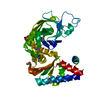+ Open data
Open data
- Basic information
Basic information
| Entry | Database: PDB / ID: 4apw | ||||||
|---|---|---|---|---|---|---|---|
| Title | Alp12 filament structure | ||||||
 Components Components | ALP12 | ||||||
 Keywords Keywords | STRUCTURAL PROTEIN / ALP12 / ACTIN-LIKE PROTEIN | ||||||
| Function / homology | Actin-like protein, N-terminal / Actin like proteins N terminal domain / ATPase, nucleotide binding domain / Actin-like protein N-terminal domain-containing protein Function and homology information Function and homology information | ||||||
| Biological species |  CLOSTRIDIUM TETANI (bacteria) CLOSTRIDIUM TETANI (bacteria) | ||||||
| Method | ELECTRON MICROSCOPY / single particle reconstruction / negative staining / Resolution: 19.7 Å | ||||||
 Authors Authors | Popp, D. / Narita, A. / Lee, L.J. / Ghoshdastider, U. / Xue, B. / Srinivasan, R. / Balasubramanian, M.K. / Tanaka, T. / Robinson, R.C. | ||||||
 Citation Citation |  Journal: J Biol Chem / Year: 2012 Journal: J Biol Chem / Year: 2012Title: Novel actin-like filament structure from Clostridium tetani. Authors: David Popp / Akihiro Narita / Lin Jie Lee / Umesh Ghoshdastider / Bo Xue / Ramanujam Srinivasan / Mohan K Balasubramanian / Toshitsugu Tanaka / Robert C Robinson /  Abstract: Eukaryotic F-actin is constructed from two protofilaments that gently wind around each other to form a helical polymer. Several bacterial actin-like proteins (Alps) are also known to form F-actin- ...Eukaryotic F-actin is constructed from two protofilaments that gently wind around each other to form a helical polymer. Several bacterial actin-like proteins (Alps) are also known to form F-actin-like helical arrangements from two protofilaments, yet with varied helical geometries. Here, we report a unique filament architecture of Alp12 from Clostridium tetani that is constructed from four protofilaments. Through fitting of an Alp12 monomer homology model into the electron microscopy data, the filament was determined to be constructed from two antiparallel strands, each composed of two parallel protofilaments. These four protofilaments form an open helical cylinder separated by a wide cleft. The molecular interactions within single protofilaments are similar to F-actin, yet interactions between protofilaments differ from those in F-actin. The filament structure and assembly and disassembly kinetics suggest Alp12 to be a dynamically unstable force-generating motor involved in segregating the pE88 plasmid, which encodes the lethal tetanus toxin, and thus a potential target for drug design. Alp12 can be repeatedly cycled between states of polymerization and dissociation, making it a novel candidate for incorporation into fuel-propelled nanobiopolymer machines. | ||||||
| History |
|
- Structure visualization
Structure visualization
| Movie |
 Movie viewer Movie viewer |
|---|---|
| Structure viewer | Molecule:  Molmil Molmil Jmol/JSmol Jmol/JSmol |
- Downloads & links
Downloads & links
- Download
Download
| PDBx/mmCIF format |  4apw.cif.gz 4apw.cif.gz | 881.2 KB | Display |  PDBx/mmCIF format PDBx/mmCIF format |
|---|---|---|---|---|
| PDB format |  pdb4apw.ent.gz pdb4apw.ent.gz | 690.9 KB | Display |  PDB format PDB format |
| PDBx/mmJSON format |  4apw.json.gz 4apw.json.gz | Tree view |  PDBx/mmJSON format PDBx/mmJSON format | |
| Others |  Other downloads Other downloads |
-Validation report
| Summary document |  4apw_validation.pdf.gz 4apw_validation.pdf.gz | 896.6 KB | Display |  wwPDB validaton report wwPDB validaton report |
|---|---|---|---|---|
| Full document |  4apw_full_validation.pdf.gz 4apw_full_validation.pdf.gz | 2 MB | Display | |
| Data in XML |  4apw_validation.xml.gz 4apw_validation.xml.gz | 334.7 KB | Display | |
| Data in CIF |  4apw_validation.cif.gz 4apw_validation.cif.gz | 413.7 KB | Display | |
| Arichive directory |  https://data.pdbj.org/pub/pdb/validation_reports/ap/4apw https://data.pdbj.org/pub/pdb/validation_reports/ap/4apw ftp://data.pdbj.org/pub/pdb/validation_reports/ap/4apw ftp://data.pdbj.org/pub/pdb/validation_reports/ap/4apw | HTTPS FTP |
-Related structure data
| Related structure data |  2068MC M: map data used to model this data C: citing same article ( |
|---|---|
| Similar structure data |
- Links
Links
- Assembly
Assembly
| Deposited unit | 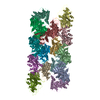
|
|---|---|
| 1 |
|
- Components
Components
| #1: Protein | Mass: 36991.953 Da / Num. of mol.: 16 Source method: isolated from a genetically manipulated source Source: (gene. exp.)  CLOSTRIDIUM TETANI (bacteria) / Production host: CLOSTRIDIUM TETANI (bacteria) / Production host:  |
|---|
-Experimental details
-Experiment
| Experiment | Method: ELECTRON MICROSCOPY |
|---|---|
| EM experiment | Aggregation state: FILAMENT / 3D reconstruction method: single particle reconstruction |
- Sample preparation
Sample preparation
| Component | Name: FILAMENT STRUCTURE OF AN ACTIN -LIKE PROTEIN, ALP12, IN CLOSTRIDIUM TETANI Type: COMPLEX |
|---|---|
| Buffer solution | pH: 7.5 |
| Specimen | Embedding applied: NO / Shadowing applied: NO / Staining applied: YES / Vitrification applied: NO |
| EM staining | Type: NEGATIVE / Material: uranyl acetate |
| Specimen support | Details: CARBON |
| Vitrification | Details: NEGATIVELY STAINED |
- Electron microscopy imaging
Electron microscopy imaging
| Microscopy | Model: HITACHI H7600 / Date: Sep 6, 2011 |
|---|---|
| Electron gun | Electron source: LAB6 / Accelerating voltage: 100 kV / Illumination mode: FLOOD BEAM |
| Electron lens | Mode: BRIGHT FIELD / Nominal magnification: 40000 X / Nominal defocus max: 5000 nm / Nominal defocus min: 800 nm |
| Image recording | Film or detector model: KODAK SO-163 FILM |
| Image scans | Num. digital images: 31 |
- Processing
Processing
| EM software | Name: EOS / Category: 3D reconstruction | ||||||||||||
|---|---|---|---|---|---|---|---|---|---|---|---|---|---|
| CTF correction | Details: EACH SCANNED IMAGE | ||||||||||||
| 3D reconstruction | Method: SINGLE PARTICLE ANALYSIS / Resolution: 19.7 Å / Num. of particles: 5582 / Nominal pixel size: 2.68 Å / Actual pixel size: 2.68 Å Details: SINGLE PARTICLE ANALYSIS USING EOS SOFTWARE PACKAGE SUBMISSION BASED ON EXPERIMENTAL DATA FROM EMDB EMD-2068. (DEPOSITION ID: 10712). Symmetry type: HELICAL | ||||||||||||
| Atomic model building | Protocol: RIGID BODY FIT / Space: REAL / Details: METHOD--RIGID BODY REFINEMENT PROTOCOL--X-RAY | ||||||||||||
| Atomic model building | PDB-ID: 3JS6 Accession code: 3JS6 / Source name: PDB / Type: experimental model | ||||||||||||
| Refinement | Highest resolution: 19.7 Å | ||||||||||||
| Refinement step | Cycle: LAST / Highest resolution: 19.7 Å
|
 Movie
Movie Controller
Controller



 UCSF Chimera
UCSF Chimera

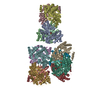
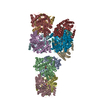
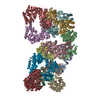

 PDBj
PDBj